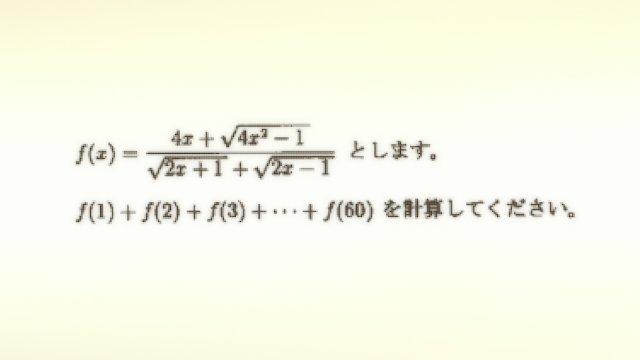First Post and First Proof
I pondered for a rather long time about what to write in my first post. Among those ideas were an in depth view about what I may write about/the things I like; or maybe expand more on the type of person I am, compared to the short blurb I wrote on the "About Me" section.
I ended up concluding, however, that those type of things will show up little by little as I write more posts. So, without further ado, let's dive right in and start away with a relatively short proof.
While browsing the internet randomly like the good millennial I am (there we go, now you know a little bit more about me!), I ran into the following identity attributed to Euler:
\[\begin{equation}\label{(1)}\dfrac{\sin(x)}{x} = \prod_{k=1}^{\infty}\cos\left(\dfrac{x}{2^k}\right)\end{equation}\]
Nothing like weird symbols to make you feel smart, right? This may look intimidating, but the "pi" (yes, that's the capital $\pi$) is just shorthand for a product of terms, à la $\sum$ used for sums.
Since it was not given, I figured I'd have a go at proving it and I came up with the following:
From the double-angle formulas, we know that:
\[\begin{equation}\label{(2)}\sin(x) = 2\sin\left(\dfrac{x}{2}\right) \cos\left(\dfrac{x}{2}\right)\end{equation}\]
Before I continue, a confession: I remember almost none of the trig identities (thank Wikipedia for the one above) and I find it rather useless to try to devote time into remembering them by heart.
Putting aside pedagogical positions for now, I used the double-angle formula again in the next step, but this time on the sine of the right hand side of $\eqref{(2)}$. Thus we then get:
$$\sin(x) = 2 \Big[ 2 \sin\left(\dfrac{x}{4}\right)\cos\left(\dfrac{x}{4}\right) \Big] \cos\left(\dfrac{x}{2}\right)$$
Rearranging a bit:
$$\sin(x) = 4\sin\left(\dfrac{x}{4}\right) \cos\left(\dfrac{x}{2}\right) \cos\left(\dfrac{x}{4}\right)$$
The reason I did this was to make that $\cos\left(\dfrac{x}{4}\right)$ found in $\eqref{(1)}$ show up (if you can't see it just expand the product!).
From here on, I just repeated the same procedure with the sine that pops up on the right hand side of the equality at each step. Doing this $n$ times, rearranging as before, and writing with $\prod$ notation we get:
\[\begin{equation*}\sin(x) = 2^n\sin\left(\dfrac{x}{2^n}\right)\cos\left(\dfrac{x}{2}\right)\cos\left(\dfrac{x}{4}\right)\ldots \cos\left(\dfrac{x}{2^n}\right) = 2^n\sin\left(\dfrac{x}{2^n}\right) \prod_{k=1}^n\cos\left(\dfrac{x}{2^k}\right)\end{equation*}\]
When $n$ goes to infinity, this product becomes the right hand side of $\eqref{(1)}$, so to finish we just need to prove that:
\[\begin{equation*}\lim_{n \to \infty}2^n\sin\left(\dfrac{x}{2^n}\right) = x \end{equation*}\]
To show this is indeed true, I replaced $\sin(x)$ with its Taylor expansion. As a side note, there are other ways to calculate this limit, but this is the first one I came up with. If you haven't studied Taylor series I apologize (not really, go study now!) for the leap of faith:
$$\sin(x) = x-\dfrac{x^3}{3!}+\dfrac{x^5}{5!}- \ldots$$
The limit can then be calculted as follows:
$$\lim_{n \to \infty}2^n\sin\left(\dfrac{x}{2^n}\right) = \lim_{n \to \infty}2^n \left[\left(\dfrac{x}{2^n}\right)-\dfrac{{\left(\dfrac{x}{2^n}\right)}^3}{3!}+\dfrac{{\left(\dfrac{x}{2^n}\right)}^5}{5!}- \ldots \right] = \lim_{n \to \infty}2^n \left(\dfrac{x}{2^n}-\dfrac{x^3}{3!2^{3n}}+\dfrac{x^5}{3!2^{5n}}- \ldots \right)$$
\[= \lim_{n \to \infty} x - \dfrac{x^3}{3!2^{2n}} + \dfrac{x^5}{5!2^{4n}} - \ldots = x\] Q.E.D.
This proof isn't anything out of the ordinary (I'm pretty sure a determined high school student could do it!), but that's part of the beauty of it. When I first saw the identity, with its infinite product of cosines and powers of 2, I certainly didn't expect it to go that smoothly.
That's about it for now! I do hope the level of explanation was adequate; I didn't want to take many big leaps but I also didn't want to stop to explain everything. Feel free to write any comments, questions, or complaints! This is also my first try at blogging for real so any advice about anything and everything would be greatly appreciated.
Have a nice day/night!
I ended up concluding, however, that those type of things will show up little by little as I write more posts. So, without further ado, let's dive right in and start away with a relatively short proof.
While browsing the internet randomly like the good millennial I am (there we go, now you know a little bit more about me!), I ran into the following identity attributed to Euler:
\[\begin{equation}\label{(1)}\dfrac{\sin(x)}{x} = \prod_{k=1}^{\infty}\cos\left(\dfrac{x}{2^k}\right)\end{equation}\]
Nothing like weird symbols to make you feel smart, right? This may look intimidating, but the "pi" (yes, that's the capital $\pi$) is just shorthand for a product of terms, à la $\sum$ used for sums.
Since it was not given, I figured I'd have a go at proving it and I came up with the following:
From the double-angle formulas, we know that:
\[\begin{equation}\label{(2)}\sin(x) = 2\sin\left(\dfrac{x}{2}\right) \cos\left(\dfrac{x}{2}\right)\end{equation}\]
Before I continue, a confession: I remember almost none of the trig identities (thank Wikipedia for the one above) and I find it rather useless to try to devote time into remembering them by heart.
Putting aside pedagogical positions for now, I used the double-angle formula again in the next step, but this time on the sine of the right hand side of $\eqref{(2)}$. Thus we then get:
$$\sin(x) = 2 \Big[ 2 \sin\left(\dfrac{x}{4}\right)\cos\left(\dfrac{x}{4}\right) \Big] \cos\left(\dfrac{x}{2}\right)$$
Rearranging a bit:
$$\sin(x) = 4\sin\left(\dfrac{x}{4}\right) \cos\left(\dfrac{x}{2}\right) \cos\left(\dfrac{x}{4}\right)$$
The reason I did this was to make that $\cos\left(\dfrac{x}{4}\right)$ found in $\eqref{(1)}$ show up (if you can't see it just expand the product!).
From here on, I just repeated the same procedure with the sine that pops up on the right hand side of the equality at each step. Doing this $n$ times, rearranging as before, and writing with $\prod$ notation we get:
\[\begin{equation*}\sin(x) = 2^n\sin\left(\dfrac{x}{2^n}\right)\cos\left(\dfrac{x}{2}\right)\cos\left(\dfrac{x}{4}\right)\ldots \cos\left(\dfrac{x}{2^n}\right) = 2^n\sin\left(\dfrac{x}{2^n}\right) \prod_{k=1}^n\cos\left(\dfrac{x}{2^k}\right)\end{equation*}\]
When $n$ goes to infinity, this product becomes the right hand side of $\eqref{(1)}$, so to finish we just need to prove that:
\[\begin{equation*}\lim_{n \to \infty}2^n\sin\left(\dfrac{x}{2^n}\right) = x \end{equation*}\]
To show this is indeed true, I replaced $\sin(x)$ with its Taylor expansion. As a side note, there are other ways to calculate this limit, but this is the first one I came up with. If you haven't studied Taylor series I apologize (not really, go study now!) for the leap of faith:
$$\sin(x) = x-\dfrac{x^3}{3!}+\dfrac{x^5}{5!}- \ldots$$
The limit can then be calculted as follows:
$$\lim_{n \to \infty}2^n\sin\left(\dfrac{x}{2^n}\right) = \lim_{n \to \infty}2^n \left[\left(\dfrac{x}{2^n}\right)-\dfrac{{\left(\dfrac{x}{2^n}\right)}^3}{3!}+\dfrac{{\left(\dfrac{x}{2^n}\right)}^5}{5!}- \ldots \right] = \lim_{n \to \infty}2^n \left(\dfrac{x}{2^n}-\dfrac{x^3}{3!2^{3n}}+\dfrac{x^5}{3!2^{5n}}- \ldots \right)$$
\[= \lim_{n \to \infty} x - \dfrac{x^3}{3!2^{2n}} + \dfrac{x^5}{5!2^{4n}} - \ldots = x\] Q.E.D.
This proof isn't anything out of the ordinary (I'm pretty sure a determined high school student could do it!), but that's part of the beauty of it. When I first saw the identity, with its infinite product of cosines and powers of 2, I certainly didn't expect it to go that smoothly.
That's about it for now! I do hope the level of explanation was adequate; I didn't want to take many big leaps but I also didn't want to stop to explain everything. Feel free to write any comments, questions, or complaints! This is also my first try at blogging for real so any advice about anything and everything would be greatly appreciated.
Have a nice day/night!


Comments
Post a Comment